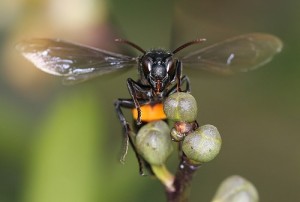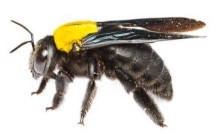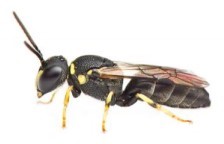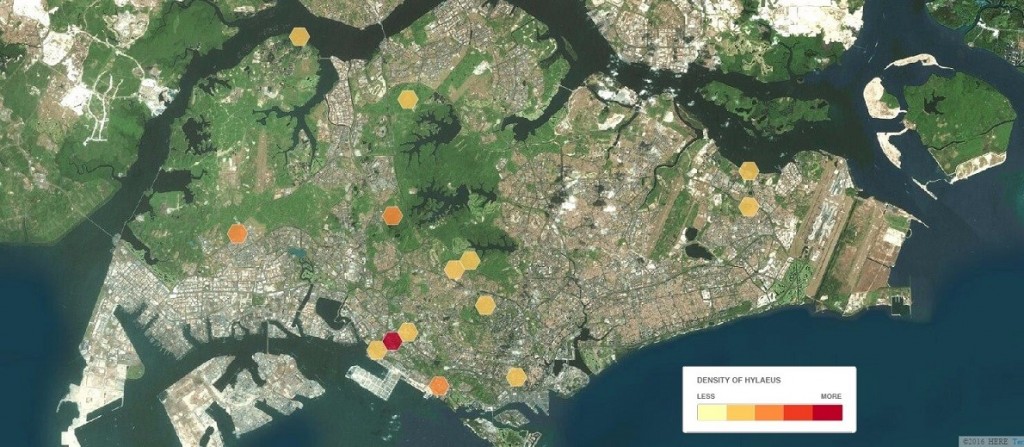In yesterday’s lecture, we had the privilege of listening to Dr John Ascher share more about bees in the city. Of all the new information gleaned, perhaps the most relevant one – to daily life, that is – we learnt was how to differentiate between a wasp and a bee: bees are usually [1] hairy, with broad hind legs and a tongue for sipping nectar, all of which wasps lack. Because most people are unable to tell the difference, bees are often misrepresented as dangerous creatures when in fact, it is wasps that are much more aggressive and lethal [2] – as natural predators, their streamlined bodies allow them to attack at much greater speeds and sting their prey multiple times, whereas bees are much slower and die after stinging once.

This Greater Banded Hornet (a social wasp) is the deadly one! (Photographed by Eddie Tan, 2012 )

The giant honey bee, Apis dorsata, also has a deadly sting (if you’re allergic), but don’t worry, it lives in the treetops so you’re not likely to spot it! (Photographed by Zestin Soh, in (Soh & Ngiam, 2013 [3])
Most bees we see in urban parks and gardens, unlike the giant honeybee (pictured above), are actually non-aggressive and also non-venomous
[4]. Thus, there is actually no need to run away screaming whenever we see or hear that familiar buzzing sound – unless, of course, you think you’ve met a hornet, then by all means please do run!
[5]
On a more serious note, we also learnt why cities are important habitats for bees – they serve as a refuge from agricultural pesticides, mammalian megafauna and droughts, especially in cities located in drier climates. In our own tropical garden city, bees are in fact more commonly found in rooftop gardens. This is because they are unable to thrive in heavily manicured ground-level vegetation, which often grow in compact soil that are not suitable nesting sites for ground-nesters. As early successional colonizers, bees prefer habitats that have weeds and shrubs, which provide good shelter and food resources.
Following Dr Ascher’s lecture, we had a hands-on activity whereby we were given datasets on Singapore bees, which were then mapped out using this really cool online mapping tool and analyzed. After playing around with the tabs and trying to figure out how things worked, I managed to map out the distribution of Hylaeus sp.

Hylaeus sp. (photographed by Zestin Soh, in (Soh & Ngiam, 2013 [3])

Map of Singapore showing the distribution and density of Hylaeus sp. (Created using Cartodb)
At first glance, the distribution of Hylaeus sp is concentrated in the southern part of Singapore, though they are present in other parts of the city as well. Given that Hylaeus sp is found in a variety of green areas [6], they are likely to be urban adapters. This means that they are able to live opportunistically in close proximity to humans. Urban adapters are usually generalists – they aren’t picky about their meals, unlike specialists – and are able to live in altered habitats or patches. Thus, they are likely to be found in a range of urbanization gradients, which is what we see for Hylaeus sp.
However, upon closer look at the data, I realized that 1 sighting was recorded on 1876 while the rest were dated from 1972 to 1978. Hence, it is likely that the urban structure of Singapore has changed quite substantially since then (especially for the 19th century record) and the distribution seen on the map above may be misleading. To properly analyze the occurrence and habitat of Hylaeus sp, we would then need to refer to older maps of Singapore and match those with the data.
Still, based on the datasheet, we do know that Hylaeus sp is a native species and a cavity-nester. Thus, it is unsurprising that they are able to adapt well to urban environments, since man-made structures such as sidewalk or building cracks could very well serve as a home for these little creatures.
What do you guys think?
[1] Do note that there are always exceptions in nature!
[2] That is, if you happen to have an allergic reaction to its sting
[3] Soh, Z. W. W., & Ngiam, R. W. J. (2013). Flower-visiting bees and wasps in Singapore Parks (Insecta: Hymenoptera). Nature in Singapore, 6, 153-172.
[4] some don’t even have stings!
[5] Perhaps this would be a good time to brush up your knowledge of the 3 hornets we have in Singapore.
[6] They seem to be able to survive in urban parks, forests, and mangroves




